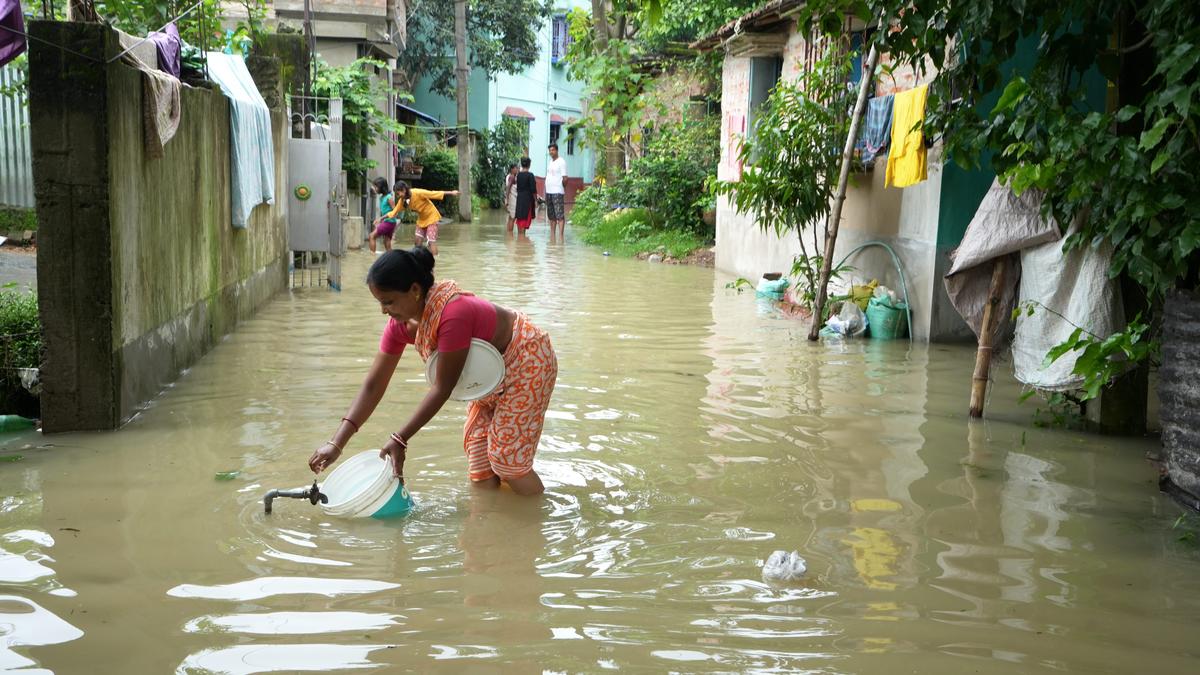The southern districts of West Bengal including Howrah, Birbhum, West Midnapore, East Midnapore, Jhargram, Bankura, Purulia, West Burdwan, and East Burdwan districts are facing a disastrous flood amidst heavy rainfall in the state. Multiple districts across southern West Bengal are inundated. The calamity is linked with several political and ecological issues like quasi-federalism, the effects of dams and hydropower plants and the climate crisis. Indian Meteorological Department has announced the possibility of heavy rainfall in the concerned area till 26 September.
Impact on locals
On 24th September the death toll was 28 according to the letter to the Prime Minister. Over three lakh people have been displaced. More than 50 villages in Malda district are submerged affecting the lives of lakhs. Infrastructure is severely damaged including the Panskura Railway station which is completely inundated.

Administration is working towards relief facilities including camps and deployment of disaster relief personnel. The fishing community and farmers are worst struck by it with a direct impact on their occupations. In the Sunderbans, ferry services are suspended for the time being. Paddy and jute farmers are speculated to suffer serious losses due to rising water levels in Ganges and Fulhar rivers which might lead to crop failure as well. Metropolises like Kolkata suffer from water logging due to mismanagement. Transportation and communication are disrupted as people wait in relief camps for the situation to improve.
The locals haven’t experienced such a disaster since the last century. Various unreported deaths are caused in such circumstances by electric shocks, lack of medical amenities, snake bites etc. The occupation of the farmers and fishing community stands stagnant while food shortages are resulting in a surge in the prices of essentials.
Furthermore, agricultural fields, livestock, vehicles, machinery and equipment are the vulnerable elements during calamities like floods. In a ground report by The Wire, a paddy farmer said, “We’ve been living in a government shelter with a tarpaulin for cover, enduring stormy weather and floodwaters for a month. Our paddy and jute crops have rotted. Who will compensate us?“
The loopholes in the Damodar Valley Reservoir Regulation Committee
In a letter to Prime Minister Narendra Modi, the Chief Minister of West Bengal, Mamta Banerjee wrote that the cause of the floods was the “unprecedented, unplanned and unilateral” release of around 500,000 cusecs of water from the Damodar Valley Corporation’s Maithon and Panchet dams. CM termed it a “man-made flood” as the committee has shown instances of negligence and ignorance in the past as well. She further wrote, “It is also alarming that DVC appears to have shifted focus from its primary objective of flood control in the Damodar river, as mandated by law, to power generation, disregarding the social obligation. This shift has sacrificed the interests of the downstream state of W. Bengal.”

According to the CM, the Damodar Valley Corporation was supposed to wait for the water levels to reach the maximum flood management levels at the two reservoirs including the Maithon and Panchet dams. These dams have never released such a quantum of discharge in the past. In 2021, as well the Chief Minister wrote a letter to the Prime Minister concerning artificial floods in West Bengal due to arbitrary and excessive discharge from dams under the Damodar Valley Corporation.
On 22nd September Santanu Basu, the Power Secretary of West Bengal resigned as state representative from Damodar Valley Corporation followed by an engineer who resigned to protest against “unplanned and uncalibrated” water discharge. According to the data of the West Bengal Disaster Management and Civil Defence Department the last flood that happened in the year 2013 was also caused by the mismanagement of the Damodar Valley Corporation. To cite from the data, “Heavy rainfall & water release from various dams by DVC led to widespread flooding in the districts of Paschim & Purba Medinipur, Howrah, Hooghly, Bardhaman and Bankura Causing 17 deaths, 8790 villages affected, and affecting 2.1 million people.”
Response of the Government
While the government is claiming the adequacy of relief camps mismanagement, theft is being seen. The conflict has become a site of a state-centre controversy. The West Bengal governor CV Anand Bose has attacked Mamta Banerjee, terming her “shameless and irresponsible.” However, the criticism and letters from the Chief Minister remain unanswered by the Centre.

The central government regulates Damodar Valley Corporation, The Ganga Action Plan and flood control. CM has warned that the DVC is still releasing water and the floods may worsen with two more anticipated depressions which will lead to heavy rainfall in newer districts. Therefore, the area impacted by flood is anticipated to increase.
Surge in conflicts due to Hydropower plants
It is paradoxical that multi purpose river valley projects which are built with the primary aim of flood control become a source of artificial floods. In the North eastern region currently 168 hydropower plants projects are being planned on the Brahmaputra and the Barak (Meghna). These include conflicts with indigenous communities as well as potential natural calamities. The construction of 512 MW Tapovan Vishnugad project, in Joshimath, Uttarakhand is still underway. This was ahead of a 17 memeber expert committee’s recommendation led by environmentalist Ravi Chopra which concluded “irreversible impact” on the ecology of the region.
Towards a solution
These conflicts are indicative of larger issues in the governance of water resources. Social Impact Assessments (SIAs) along with Environment Impact Assessment (EIA) to streamline and structure the regulation and construction of dams and hydropower projects. The irrigation and water department of West Bengal have suggested following reforms that are being implemented for more than 60 years now.
The measures generally implemented are the embankments and river training works, improvement of drainage systems, providing flood storage in reservoirs, and construction of multi-purpose reservoirs among others. A more context specific resolution might be added to these.
About the author(s)
Anchal is a writer, poet and spoken word artist based in New Delhi. Her works have been published on various platforms, including Enroute Indian History Blogs, Indian Review E-Journal and department and annual magazines of Miranda House, Kirori Mal College and Gargi College. Currently, she is pursuing an MA in English at Jawaharlal Nehru University, New Delhi and loitering around the city.







It was a planned release, and everybody in the districts were notified. The state Government is trying to divert attention from other issues. https://indianexpress.com/article/cities/kolkata/opp-accuses-mamata-of-lying-waves-state-depts-letter-on-dvcs-water-release-alert-9588453/